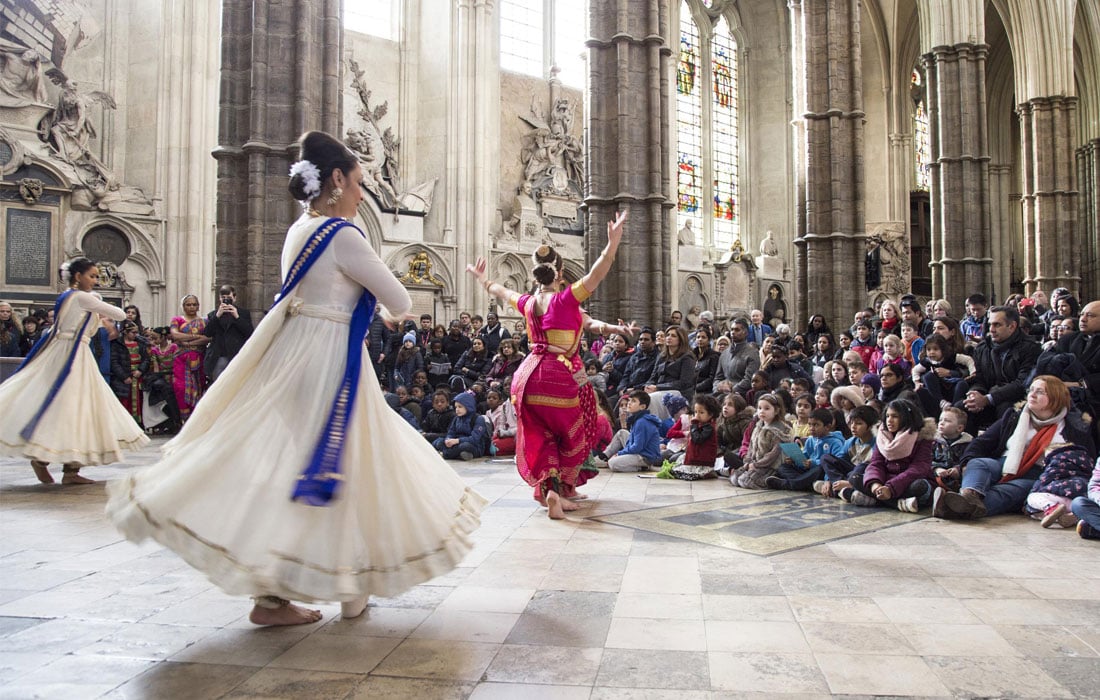
Children enjoying a performance of classical Indian dance at Westminster Abbey
Photo: Courtesy of Westminster Abbey
Leading with an audience focus
Over 25 years the role of cultural marketers has expanded, but the focus remains on audience relationships. Cath Hume examines the changes and challenges.
Twenty-five years ago arts marketing was an emerging profession, with some pioneers coming together to create a space where they could share ideas, push their practice forward and professionalise the sector. This led to the birth of the AMA and over the last quarter of a century we have worked towards the realisation of the pioneers’ original ambitions.
One of those pioneers was Gerri Morris, Director of Morris Hargreaves McIntyre, who you can hear talking to me on the second podcast in our 6 Degrees series on AMAculturehive.
Changing focus
We continue to work with marketers, but what this means has changed. Reaching and engaging audiences is what our members do, day in, day out. But the detail of what they do has changed dramatically. Today our membership is made up of practitioners working across the whole gamut of audience development, social media and digital, ticketing, business planning, CRM, data insight and wider communications including press and PR.
Through our training, events and resources we have played a part in shaping and sharing the learning and skills needed. Over the years we have led our members through huge shifts in the political, economic and technical environment, boosting their existing skillset and helping them navigate new trends and ways of working across teams and specialisms.
For the first time our annual Digital Marketing Day was hosted in two linked locations, Glasgow and London, with a range of tactical, strategic and leadership-focused sessions. There is still much to be done, and however large or small a team, it can be tough to keep up with change, and easy to be overwhelmed.
You can find a range of support to help you stay audience-focused in both your short and long-term activity on our website alongside thousands of free resources on AMAculturehive. Read the latest blog by Amy Firth our Head of Marketing – Membership, full of practical tips on how to embrace uncertainty and change and come out smiling.
Lack of recognition
We see marketers being recognised for the essential role they play in their organisations and in the sector. However, this recognition arguably came too late in Northern Ireland. A recent Arts Council of Northern Ireland internal report, released following a Freedom of Information request by ArtsProfessional, finds that between 2014 and 2017 audiences across its portfolio of annually funded organisations fell by over a quarter.
The report states that the fall in audience numbers may be “because of the low level of marketing/publicity/promotion and cuts in other overheads”, adding that this combination “could be described as an unfortunate or even a false economy”. We need to ensure that leaders value their marketing teams highly enough to recognise any false economies.
Importance of inclusion
However, most organisations are now thinking carefully about the types of relationships they can, should and want to develop with their audiences, visitors, co-creators and communities. We see examples of organisations proving that being inclusive is good for business, both in its narrowest form of financial growth but more importantly in terms of social equality.
You can find a collection of practical guides, videos, blogs and case studies on keeping inclusion, in its broadest sense, at the heart of your work on AMAculturehive.
We are in the age of experience and our members are leading the way by taking on board new thinking and the latest developments and sharing their learning across the sector – both successes and failures. This progress is to be celebrated but can add even more stress and challenge to roles that are already demanding.
Work and wellbeing
Talk about wellbeing is everywhere at the moment but we need to help all practitioners recognise the importance of looking after themselves and their colleagues. The most common complaint about working life these days is that there is no time to stop and think, to reflect on what is working well or what needs improving — and definitely no time to check up on how we’re feeling about ourselves. But this is a sure-fire way to burn out, lose motivation and ultimately not give our best to the work we love.
We offer support through online training on personal and professional wellbeing and have recently launched a series of commissioned blogs, How I Cope, where a wide range of voices discuss their ways of meeting this prevalent challenge.
Leadership and change
For us to support our growing membership, we’ve worked with over a hundred CEOs over the last three years to help them realise change within their organisations. We share as much of the learning from this as we can via AMAculturehive, alongside the leadership collective intelligence we gather from across the sector.
Our current political, economic and social challenges mean that arts and cultural organisations have a clear and vital role to play in our communities – local and national. This context also means that organisations have a big challenge to become and remain resilient. We believe it is audience-focused organisations that will navigate these challenges and make the changes to themselves and the sector that need to happen to achieve a future where culture is part of everybody’s life.
Cath Hume is CEO of the AMA.
www.a-m-a.co.uk
Tw @CathHume
This article, sponsored and contributed by AMAculturehive, is part of a series sharing resources and learning from the online library for the sector.

Join the Discussion
You must be logged in to post a comment.